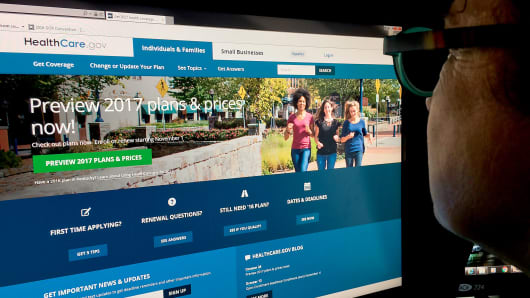
The Trump administration — which has been bashing the Affordable Care Act (ACA) for months — on Wednesday said it would make a change that could lead to higher enrollment in Affordable Care Act plans next year.
The administration said it would remove a technical speed bump in how internet-based insurance brokers sign up customers in health plans sold on HealthCare.gov, the federal ACA marketplace.
That change, which the brokers have sought for more than four years, is likely to make it easier for those third-party brokers to enroll customers in Affordable Care Act plans by removing a requirement that they have customers ping-pong between the brokers’ websites and HealthCare.gov.
“Consumers applying for individual market coverage during the upcoming open enrollment period through direct enrollment partners will now be able to complete their application using one website,” said the Centers for Medicare and Medicaid Services.
And because the process will be easier, more people could end up enrolling, particularly customers who receive financial aid that reduces their monthly plan premiums.
Web brokers long have said that they can help increase Affordable Care Act enrollment because of their marketing budgets, customer service and online shopping technology.
CMS, which runs HealthCare.gov, said the change was being made to reduce confusion and difficulty that customers had experienced when enrolling in HealthCare.gov plans by using web brokers.
“This is another important step to help create stability in the health insurance market,” said CMS Administrator Seema Verma.
“It is common sense to make it as simple and easy as possible for consumers to shop for and access health coverage. It is time to get the federal government out of the way and give patients the best tools to make their own health-care decision,” Verma said.
Scott Flanders, CEO of eHealth, the web-based broker that had been most vocal about the need for the kind of change announced Wednesday, said, “These new regulations are a step in the right direction.”
Flanders said the previous system of requiring customers to bounce back and forth between websites to enroll in subsidized Affordable Care Act plans was “a ridiculous process.”
Shankar Srinivasan, co-founder and general manager of GetInsured, another major web health broker, also lauded the elimination of “the dreaded ‘double-redirect'” that had been required for his and other companies, and said it will “make it easier for people to shop for health insurance.”
HealthCare.gov sells individual health plans to people in 39 states. The federal exchange is responsible for more than 9 million Affordable Care Act sign-ups, about 75 percent of the national enrollment tally.
For the past four years, HealthCare.gov has allowed web-based brokers to handle “direct enrollment” for customers. The 12 exchanges run by individual states and the District of Columbia do not allow web brokers to enroll customers in subsidized plans sold on those exchanges.
In direct enrollment, customers visit the broker’s website and sign up in plans that are offered on HealthCare.gov.
But federal officials had required the brokers to perform a so-called redirect when signing up those customers. That meant the broker had to electronically transfer the customer to HealthCare.gov, where the customer had their eligibility for financial aid verified.
The customer then was provided a link which they could click to be sent back to the broker’s website, and complete the enrollment process.
But many customers did not end up clicking that link, which in turn meant that brokers did not get their business, and the commission from a sign-up.
EHealth said that the completion rate for customers who started an enrollment process on their site without having to be sent to HealthCare.gov for subsidy eligibility was 40 percent. But that completion rate fell to just 10 percent when customers had to be sent to HealthCare.gov.
An eHealth spokesman said the company hoped that state-run Affordable Care Act exchanges would follow HealthCare.gov’s example and allow direct enrollment for their health plans from web brokers.
Jeff Smedsrud, co-founder of Healthcare.com, a privately run health insurance comparison and shopping site, called the change in direct enrollment by brokers “a very nice win for consumers.”
“It makes buying health insurance online easier and faster — important things for young, healthy consumers,” Smedsrud said.
“Because enrollment will be quicker, those who want — but don’t need — health insurance will be more likely to buy. This is small, but an important step on a road to make health insurance a bit more affordable. It will improve the risk pool for those buying subsidy-eligible health plans.”
Wednesday’s announcement by CMS comes two days after the agency, citing very low enrollment, said that it will propose that HealthCare.gov stop enrolling people in SHOP plans sold on that exchange, and instead have insurers or brokers directly handle enrollment. SHOP plans are available for businesses that employ 50 or fewer full-time workers.
CMS said that under the proposal, HealthCare.gov would still handle eligibility verification for SHOP customers.
Fewer than 39,000 individuals are covered by a SHOP plan sold on HealthCare.gov, and fewer than 233,000 people are covered nationally by all SHOP plans sold on that exchange and by state-run Affordable Care Act marketplaces.
Source: http://www.cnbc.com/2017/05/17/trump-could-boost-obamacare-enrollment-by-removing-sign-up-speed-bump.html

